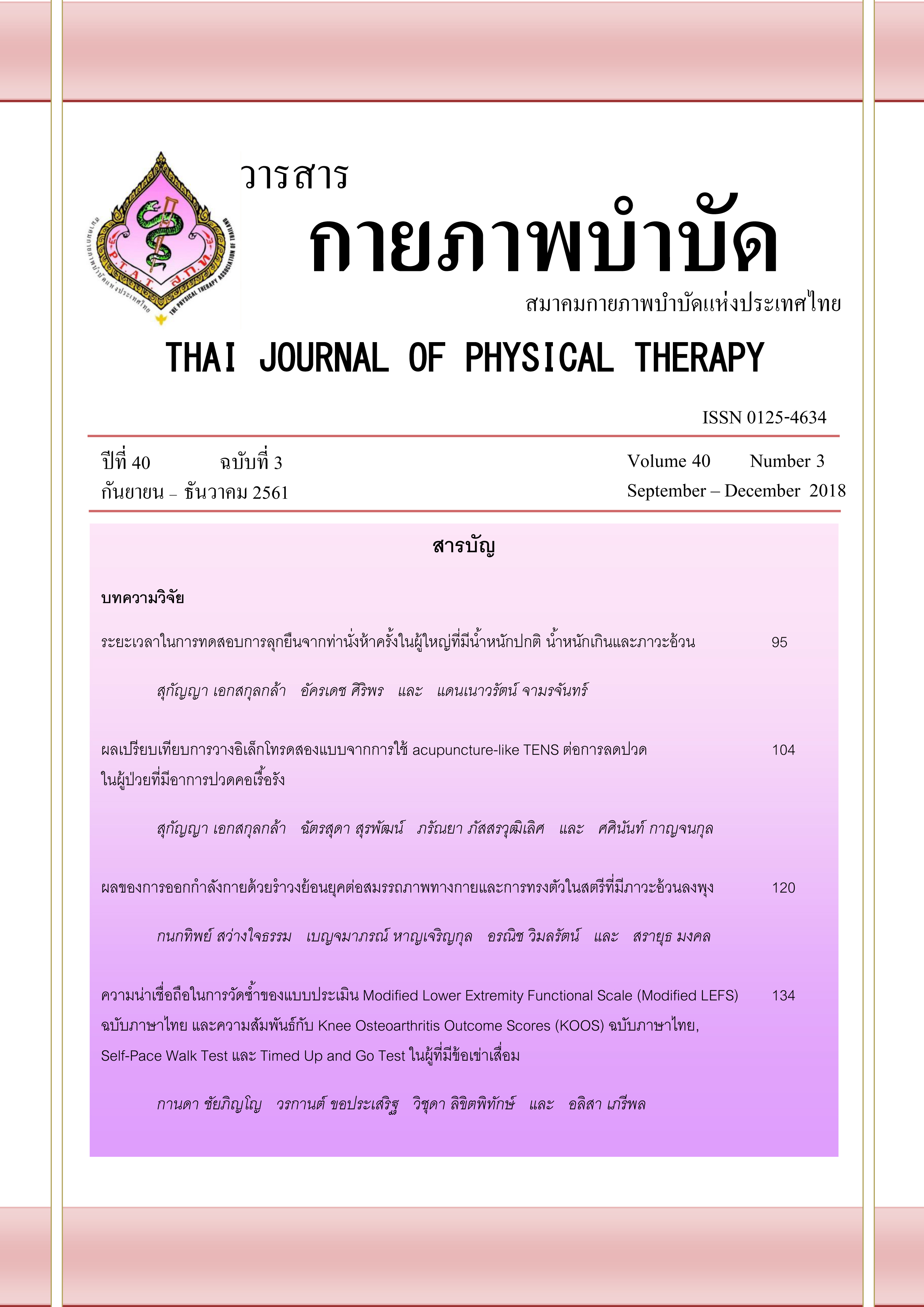ระยะเวลาในการทดสอบการลุกยืนจากท่านั่งห้าครั้งในผู้ใหญ่ที่มีน้ำหนักปกติ น้ำหนักเกินและภาวะอ้วน
Main Article Content
บทคัดย่อ
ที่มาและความสำคัญ: ดัชนีมวลกายเป็นค่าสัดส่วนของน้ำหนักตัวและส่วนสูง ซึ่งองค์การอนามัยโลกใช้เกณฑ์ของค่าดัชนีมวลกายเป็นแบบคัดกรองภาวะน้ำหนักเกินและภาวะอ้วน การทดสอบลุกขึ้นยืนจากท่านั่งห้าครั้ง เป็นการทดสอบที่นิยมใช้วัดความสามารถในการทรงตัวและความแข็งแรงของกล้ามเนื้อขา มีรายงานว่าการเพิ่มขึ้นของค่าดัชนีมวลกายมีผลต่อความสามารถในการทรงตัวในขณะอยู่นิ่ง การถ่ายเทน้ำหนัก และความแข็งแรงของกล้ามเนื้อขา อย่างไรก็ตาม หลักฐานเกี่ยวกับระยะเวลาในการทดสอบการลุกขึ้นยืนจากท่านั่งห้าครั้งในผู้ใหญ่ที่มีค่าดัชนีมวลกายแตกต่างกัน ยังมีอยู่จำกัด
วัตถุประสงค์: เพื่อเปรียบเทียบระยะเวลาในการทดสอบการลุกขึ้นยืนจากท่านั่งห้าครั้งในผู้ใหญ่ที่มีน้ำหนักปกติ ผู้ที่มีภาวะน้ำหนักเกิน และผู้ที่มีภาวะอ้วน
วิธีการวิจัย: อาสาสมัครทั้งเพศชายและเพศหญิง จำนวน 54 คน อายุระหว่าง 18-40 ปี แบ่งออกเป็น 3 กลุ่ม โดยใช้ค่าดัชนีมวลกาย (body mass index, BMI) ได้แก่ 1) กลุ่มที่มีภาวะน้ำหนักปกติ (BMI = 18.5-24.9 กิโลกรัมต่อตารางเมตร; n = 18) กลุ่มที่มีภาวะน้ำหนักเกิน (BMI = 25.0-29.9 กิโลกรัมต่อตารางเมตร; n = 18) และ 3) กลุ่มที่มีภาวะอ้วน (BMI ³ 30 กิโลกรัมต่อตารางเมตร; n = 18) อาสาสมัครถูกทดสอบด้วยการลุกขึ้นยืนจากท่านั่งห้าครั้งอย่างเร็วที่สุดเท่าที่จะทำได้ และจับเวลาที่ใช้ในการทำการลุกขึ้นยืนจากท่านั่งห้าครั้ง
ผลการวิจัย: กลุ่มที่มีภาวะอ้วนใช้เวลาในการทดสอบการลุกขึ้นยืนจากท่านั่งห้าครั้ง (11.00±0.38 วินาที) มากกว่าอย่างมีนัยสำคัญทางสถิติเมื่อเทียบกับกลุ่มที่มีภาวะน้ำหนักเกิน (9.97±0.32 วินาที) และกลุ่มที่มีน้ำหนักปกติ (9.80±0.32 วินาที) (p < 0.05) ในขณะที่กลุ่มที่มีภาวะน้ำหนักเกินใช้เวลาไม่แตกต่างกับกลุ่มที่มีน้ำหนักปกติ (p > 0.05)
สรุปผล: ผู้ใหญ่ที่มีน้ำหนักปกติและน้ำหนักเกินมีความสามารถในการทำการลุกขึ้นยืนจากท่านั่งห้าครั้งได้ดีเท่ากัน และทั้งสองกลุ่มมีความสามารถดีกว่าผู้ใหญ่ที่มีภาวะอ้วน
Article Details
เอกสารอ้างอิง
Dall PM, Kerr A. Frequency of the sit to stand task: An observational study of free-living adults. Appl Ergon. 2010; 41(1): 58–61.
Schenkman M, BergerRA, Rlley PO, Mann RW, Hodge WA. Whole-body movements during rising to standing from sitting. Phys Ther. 1990; 70(10): 638-51.
Frykberg GE, Häger CK. Movement analysis of sit-to-stand – research informing clinical practice. Phys Ther Rev. 2015; 20(3): 156-67.
Lord SR, Murray SM, Chapman K, Munro B, Tiedemann A. Sit-to-stand performance depends on sensation, speed, balance, and psychological status in addition to strength in older people. J Am Geriatr Soc. 2002; 57(8): M539–43.
Wallmann HW, Evans NS, Day C, Neelly KR. Interrater reliability of the five-times-sit-to-stand test. Home Health Care Manag Pract. 2013; 25(1): 13–7.
Meretta BM, Whitney SL, Marchetti GF, Sparto PJ, Muirhead RJ. The five times sit to stand test: responsiveness to change and concurrent validity in adults undergoing vestibular rehabilitation. J Vestib Res. 2006;16(4-5): 233-43.
Thapa PB, Gideon P, Fought RL, Kormicki M, Ray WA. Comparison of clinical and biomechanical measures of balance and mobility in elderly nursing home residents. J Am Geriatr Soc. 1994; 42(5): 493-500.
Annweiler C, Schott AM, Abellan van Kan G, et al. The Five-Times-Sit-to-Stand test, a marker of global cognitive functioning among community-dwelling older women. J Nutr Health Aging. 2011; 15(4): 271-6.
Goldberg A, Chavis M, Watkins J, Wilson T. The five-times-sit-to-stand test: validity, reliability and detectable change in older females. Aging Clin Exp Res. 2012; 24(4): 339–44.
Ng SSM, Cheung SY, Lai LSW, Liu ASL, Leong SHI, Fong SSM. Five times sit-to-stand test completion times among older women: Influence of seat height and arm position. J Rehabil Med. 2015; 47(3): 262–6.
Zhang F, Ferrucci L, Culham E, Metter EJ, Guralnik J, Deshpande N. Performance on five times sit-to-stand task as a predictor of subsequent falls and disability in older persons. J Aging Health. 2013; 25(3): 478–92.
Kwong PWH, Ng SSM, Chung RCK, Ng GYF. Foot placement and arm position affect the five times sit-to-stand test time of individuals with chronic stroke. Biomed Res Int. 2014; 2014:636530.
Mong Y, Teo TW, Ng SS. 5-repetition sit-to-stand test in subjects with chronic stroke: reliability and validity. Arch Phys Med Rehabil. 2010; 91(3): 407–13.
Deforche BI, Hills AP, Worringham CJ, et al. Balance and postural skills in normal-weight and overweight prepubertal boys. Int J Pediatr Obes. 2009; 4(3): 175–82.
Pataky Z, Armand S, Müller-Pinget S, Golay A, Allet L. Effects of obesity on functional capacity. Obes Silver Spring Md. 2014; 22(1): 56–62.
Del Porto H, Pechak CM, Smith DR, Reed-Jones RJ. Biomechanical effects of obesity on balance. Int J Exerc Sci. 2012; 5(4): 301-20.
Gilleard WW, Smith TT. Effect of obesity on posture and hip joint moments during a standing task, and trunk forward flexion motion. Int J Obesity. 2007; 31(2): 267-71.
World Health Organization (WHO). Obesity: Preventing and managing the global epidemic, Report of a WHO consultation, Technical report series No.894. Geneva, 2000.
Khemlani MM, Carr JH, Crosbie WJ. Muscle synergies and joint linkages in sit-to-stand under two initial foot positions. Clin Biomech Bristol Avon. 1999; 14(4): 236–46.
Siriphorn A, Chamonchant D, Boonyong S. The effects of vision on sit-to-stand movement. J Phys Ther Sci. 2015; 27(1): 83–6.
Koo TK., Li MY. A Guideline of selecting and reporting intraclass correlation coefficients for reliability research. J Chiropr Med. 2016; 15(2): 155–63.
Sullivan GM, Feinn R. Using effect size-or why the p value is not enough. J Grad Med Educ. 2012; 4(3): 279–82.
Hergenroeder AL, Brach JS, Otto AD, Sparto PJ, Jakicic JM. The influence of body mass index on self-report and performance-based measures of physical function in adult women. Cardiopulm Phys Ther J. 2011; 22(3): 11-20.
Whitney SL, Wrisley DM, Marchetti GF, Gee MA, Redfern MS, Furman JM. Clinical measurement of sit-to-stand performance in people with balance disorders: validity of data for the five-times-sit-to-stand test. Phys Ther. 2005; 85(10): 1034–45.
Galli M, Crivellini M, Sibella F, Montesano A, Bertocco P, Parisio C. Sit-to-stand movement analysis in obese subjects. Int J Obes Relat Metab Disord. 2000; 24(11): 1488-92.


